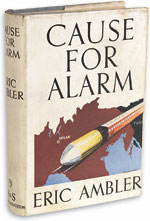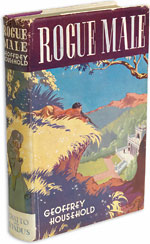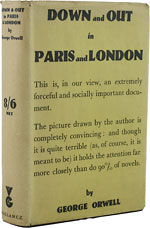Autographs and Photographs: From Button Gwinnett and J. D. Salinger to street photographer Robert Frank
Otto the Mystery Man
Eric Ambler, Cause for Alarm ($8,400) and Geoffrey Household, Rogue Male ($6,240) at Swann Galleries of New York on April 8
Otto Penzler opened his Mysterious Bookshop in New York in 1979, but has been collecting mystery fiction for some 40 years now and amassed a private library of 60,000 titles, constantly upgrading as better copies came into his shop. But home storage space was running out and, somewhat reluctantly, his British espionage and thriller holdings had to go. He explained, “Although espionage fiction has always been a favorite sub-genre … and British spy novels are among the greatest of all works in the mystery genre, it is not really at the core of my collection.”
Penzler befriended some of those writers who visited his Manhattan store and freely admitted, “I distinguished myself as an enormous irritant by asking them to inscribe my books.’’ The Ambler novel was one such triumph. A 1938 first in the now rarely seen jacket, it was inscribed “Otto, with love” in 1989.
It was in 100 Favorite Mysteries of the Century, a 2000 publication of the Independent Mystery Booksellers Association (IMBA), that Geoffrey Household’s novel was designated “the best manhunt book in history, expertly paced, tightly plotted and far surpassing John Buchan’s more famous The Thirty-Nine Steps.” Penzler’s fine 1939 first—its violet cloth binding showing no discoloration and the jacket just slightly faded at the spine—set a record.
Inevitably it was Penzler’s 007 books that saw the really big money. Bid to $50,400 was a 1955 first of Ian Fleming’s Moonraker. Like his copy of Casino Royale (sold at $33,600), it boasted a near-perfect jacket but was also signed and inscribed by the author to a well-known Fleming collector, “To Eileen M. Cond, who cannot be easily shocked!”
Only one other very special copy of this Bond novel has made more. The one inscribed to and containing annotations by Raymond Chandler made $102,000 as part of the Neville library at Sotheby’s New York in 2004.
As Good as it Gets When You are Down and Out
George Orwell, Down and Out in Paris and London £101,050 ($151,385) at Gorringes of Lewes on March 24
This was just about as good as it could possibly get for Orwell’s first book. Not only was it in a very presentable dust jacket, something almost unknown, but it was inscribed on Christmas Eve 1932 (two weeks before the official publication date) to the man who had found a publisher for his account of living rough in these two European capitals: “With the author’s kindest regards to Mr. L. P. Moore, without whose kind assistance this book would never have been published—Eric A. Blair.”
Originally called ‘A Scullion’s Diary,’ it had been turned down by Jonathan Cape and by T. S. Eliot at Faber before Moore persuaded a relative newcomer to London’s publishing scene, Victor Gollancz, to take it on—subject to the removal of easily identifiable names or characters and some toning down of the blunt language. On one of his trademark bright yellow, house-style jackets, Gollancz described the book as “an extremely forceful and socially important document … [that] holds the attention far more closely than do 90% of novels.”
Greater success was to come through such books as Animal Farm and Nineteen Eighty-Four, but a literary career had thus been launched, and it was Leonard Moore and Gollancz who had sat down together with their author to choose the Orwell pseudonym under which he was to achieve that international fame. Favorably reviewed by Compton Mackenzie, J. B. Priestley, and C. Day Lewis, it was also published in the U.S. and in France, but not until Penguin issued a cheap paperback in 1940 did Orwell’s first book reach a wider audience.
In a story perpetuated and repeated online, some media reports had it going to a collector—and by now it may even have done so—but on the sale day it was actually bought by UK dealer Christiaan Jonkers, who told me that he had been prepared to go higher still to secure this most desirable of copies.








 Ian McKay’s weekly column in Antiques Trade Gazette has been running for more than 30 years.
Ian McKay’s weekly column in Antiques Trade Gazette has been running for more than 30 years.


